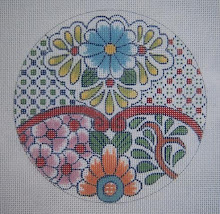 The first blog I ever saw a few years ago was that of an art quilter - I was looking for crazy quilts, and found what has occupied my mind since. I actually spend more time looking at these than I do on needlepoint blogs - as the inspiration and images are so wonderful.
The first blog I ever saw a few years ago was that of an art quilter - I was looking for crazy quilts, and found what has occupied my mind since. I actually spend more time looking at these than I do on needlepoint blogs - as the inspiration and images are so wonderful. Color schemes are particularly good on some of them, as Allison Aller's quilts - I have an entire file folder full of blocks from her quilts - with her permission, and I suspect, high amusement. She also graciously supplied me with a block to use in my very first article for Needlepoint Now, which was on adaptation and inspiration for needlepoint.
In analyzing this first picture as a color theorist, I know why the little touches of yellow and orange work so well - but it doesn't matter knowing the WHY - what matters is that it works. Allie's color sense is superb. This is the kind of thing I take to the LNS to choose silks or whatever I feel like working with (or can afford).

In the next one, the touches of blue against the orange, and the wisp of green on the right are perfect for accents. Incidentally, the butterflies are from another art quilter from Houston - Debra Spincic - who is going to have an Etsy store to sell these beauties. She makes them on her embroidery machine, and they are exquisite - the link to her is on Allison's blog, Allie's in Stitches.
The other Art Crazy Quilt/Embroidery blog I look at every morning without fail, is PINTANGLE - Sharon B.s beautiful and informative blog. So much great instruction and inspiration even for a needlepointer! She is going to start a Cyber class for Silk Ribbon Embroidery on June 18, which I wish I could find time to do (might do it anyway).
My very first experience with that was about 12 years ago when I was wanting to replace a book on Crazy Quilting - and the quilt shop sold me Judith Baker Montano's book, "Crazy Quilt Odyssey," which was full of SR - stitches and instructions. I was hooked, although I'd never seen it before, and immediately began to apply it to needlepoint. (I now own five of her books)
Sharon's work is without equal - so do go take a look if you're interested in learning, and learning it right. I call SRE my "instant gratification."
















































